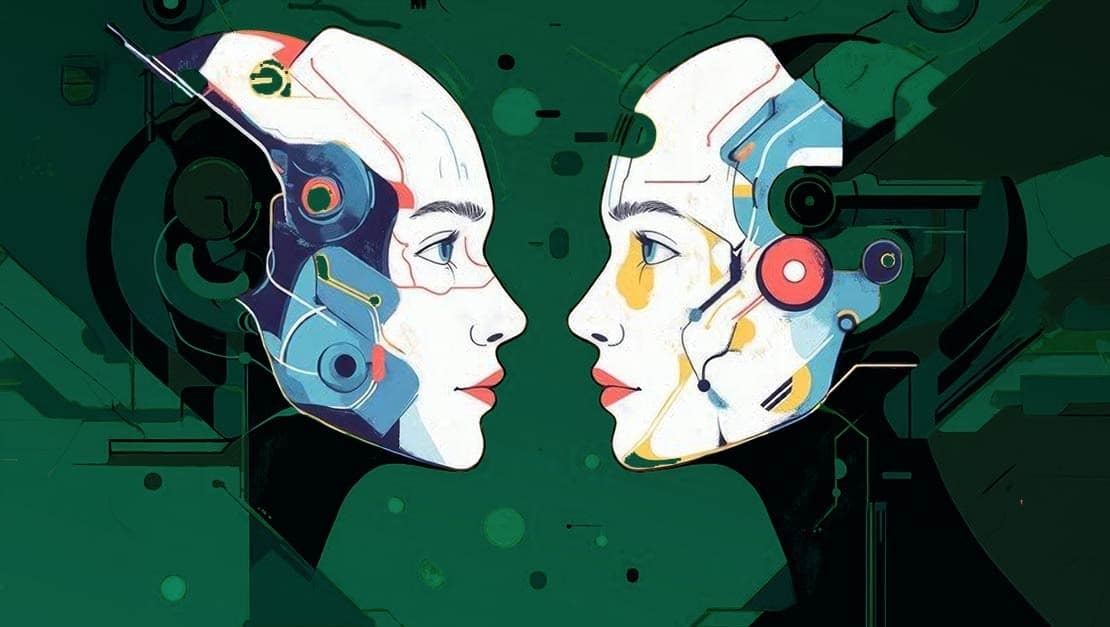Two of the most prominent voices in technology, Sam Altman (CEO, OpenAI) and Jensen Huang (CEO, NVIDIA), recently unveiled their bold visions for 2025. Both see the next wave of AI not as a mere tool but as a transformative force that will redefine the digital workforce.
Altman envisions AI agents integrating into the workplace, autonomously performing tasks, and drastically boosting productivity across industries. Meanwhile, Huang describes the rise of AI-powered agents and robotics as a “multi-trillion-dollar opportunity,” with NVIDIA leading the charge through platforms like Cosmos to enhance the “physical AI” ecosystem.
At the core of these groundbreaking innovations lies one critical component: speech and voice algorithms. These algorithms empower AI agents to engage in seamless, human-like communication, enabling their integration into diverse industries. Without conversational AI – built on the foundations of generative AI – this vision would remain incomplete.
The importance of conversational AI is echoed by other thought leaders. Mustafa Suleyman, Microsoft AI Chief, calls conversational AI “the next web browser,” emphasizing its central role in reshaping digital interactions. Similarly, Ilya Sutskever, OpenAI’s former Chief Scientist, predicts that AI-assisted interfaces will fundamentally transform how humans interact with technology, likening the shift to the evolution from command-line interfaces to graphical user interfaces.
As the future unfolds, the partnership between generative AI and conversational AI emerges as a game-changer, driving us toward a more collaborative and efficient digital era.
The Significance of Generative AI in Conversational AI
Defining Conversational AI
What makes a conversation feel natural? Is it the tone, the ability to respond intelligently, or the understanding of context? Conversational AI is about bringing all these elements together, enabling machines to engage with humans in a seamless and intuitive manner. Imagine a customer chatting with a virtual assistant about product recommendations or an employee asking a bot for real-time data – these moments highlight the bridge between human needs and machine capabilities.
In the past, conversational systems relied heavily on scripted responses and rigid frameworks. Today, generative AI has transformed them into dynamic, intelligent systems capable of understanding and responding to complex interactions. Let’s break it down.
Generative AI: The Power Behind Conversational AI
Generative AI enhances conversational systems by powering their most critical components. Let’s explore how each element has evolved:
- Speech Technologies: Previously, ASR systems struggled with noisy environments and diverse accents, often requiring ideal conditions to function effectively. Today, advanced ASR models built on generative AI can handle real-world scenarios, including background noise and varied speech patterns. These systems also deliver much faster latency, enabling near-instantaneous processing – critical for real-time applications. Moreover, they now support over 100 languages, breaking down communication barriers and making AI solutions globally accessible. They deliver high-accuracy transcription, making them indispensable for many industries.
- Natural Language Understanding (NLU): Legacy NLU systems relied on pre-defined rules, limiting their ability to comprehend nuances, idioms, or evolving slang. Generative AI changes the game by improving contextual understanding and intent recognition. Modern systems excel at multi-turn conversations – like handling a customer’s follow-up question without losing track of the original query.
Generative AI models, especially large language models (LLMs), bring vast repositories of knowledge to the table. These systems can reference extensive datasets, making them adept at providing detailed, accurate, and contextually relevant information. Additionally, breakthroughs in small language models (SLMs) enable efficient processing of massive amounts of data without compromising performance.
Advanced Retrieval-Augmented Generation (RAG) architectures further enhance this capability, allowing systems to retrieve specific knowledge from external databases or documents. This means handling vast information loads while maintaining accuracy and speed.
What’s more, modern NLU systems can mimic diverse human interactions. They simulate personalities, emotions, and even characters, tailoring responses to the individual’s style, preferences, or mood. This adaptability makes interactions feel more authentic and engaging. - Natural Language Generation (NLG): Older systems produced robotic, templated responses that felt anything but human. Generative AI enables systems to generate rich, context-aware, and human-like replies. Modern NLG supports numerous voices and languages, making it adaptable to diverse audiences around the globe.
Beyond language and voice diversity, generative AI captures the nuances of conversation – pauses, stops, moments of consideration, and shifts in tone – replicating the natural rhythm of human interactions. Picture an AI pausing thoughtfully before providing an answer, or modulating its tone to show empathy in delicate scenarios. These subtle touches bring an unprecedented level of authenticity to AI-generated responses.
Generative NLG systems can simulate human-like behavior in conversations, including turn-taking, responding with appropriate emotion, or adjusting their “character” to align with the user’s personality. This creates an experience where AI not only responds intelligently but feels genuinely relatable.
The interplay between these technologies isn’t just additive; it’s transformative. Generative AI isn’t limited to models like GPT but extends to advanced speech and voice processing systems. Whether it’s an AI assistant managing a team’s schedule or guiding users through a troubleshooting flow, conversational AI is the cornerstone of future AI agents and robotics, ready to redefine how we work and communicate.

Next-Level Collaboration: Generative AI in Conversational Systems
What happens when cutting-edge technology meets day-to-day operations? Magic? Not quite. Conversational AI isn’t the magic wand – it’s the bridge that connects AI agents – those tirelessly working behind the scenes – to the people who need them. It’s about enabling seamless communication, efficiency, and collaboration across the board. Below are examples of how conversational AI transforms various aspects of business interactions:
- Automating Complex Tasks:
While AI agents handle the heavy lifting – like processing customer inquiries or managing schedules – conversational AI provides the interface, making these actions accessible and user-friendly. It’s like having a translator who simplifies the complex without losing the detail. - Human-AI Interface:
No more clicking through endless menus or deciphering jargon-heavy dashboards. Conversational systems powered by ASR and NLU turn complex processes into intuitive, chat-based interactions. It’s like having a colleague who’s always on call, understands your needs, and responds without judgment (even if you’re asking for the fifth time). - Personalization at Scale:
Generative AI enables hyper-personalized experiences – whether it’s recommending a product, tailoring an employee’s training plan, or answering customer queries with empathy. The conversational interface ensures that these interactions feel personal, even when they’re happening at scale. - Future-Readiness:
The AI agents are the powerhouse, constantly learning and adapting to new trends. Conversational AI ensures that this adaptability is communicated effectively, helping organizations stay ahead without overwhelming their teams. Think of it as the friendly face of a tech revolution. - Knowledge Management:
AI agents continuously update and manage massive knowledge bases. Conversational AI serves as the user’s key, unlocking this treasure trove with a simple query. No more digging through documents – just ask and receive instant, accurate answers. - Lean Operations:
Operational inefficiencies become a thing of the past when AI agents streamline workflows in real time. Conversational AI acts as the interface, ensuring that relevant data is surfaced exactly when it’s needed, enabling smarter, faster decisions. - Real-Time Interaction Across Teams:
Collaboration is effortless when AI agents coordinate updates, decisions, and action points. Conversational AI keeps everyone on the same page, eliminating the chaos of endless email threads or out-of-sync team huddles. - Targeted Training and Tutorials:
AI agents identify learning needs and deliver context-specific training modules. Conversational AI ensures that these resources are interactive and easy to access, making learning feel less like a chore and more like a conversation. - Just-in-Time Communication:
Conversational AI bridges the gap between AI insights and real-world actions. Whether it’s a critical reminder or a timely alert, it ensures the right message reaches the right person at the right time.
Practical Use Cases That Redefine Business Interactions
For a taste of what’s possible, here are a few scenarios to spark your imagination:
- Customer Service: Picture this: A customer, frustrated after waiting on hold, finally gets an answer – but it’s from an AI agent. Surprisingly, it’s smooth, quick, and resolves their issue on the spot. No transfers, no bouncing between departments. Conversational AI ensures seamless dialogue – understanding context, addressing follow-ups, and even detecting the customer’s mood to respond empathetically. This isn’t just better – it’s a game-changer for CX.
- Digital Workforce Enablement: Imagine a team meeting where your AI assistant listens attentively, transcribes every word, flags action points, and even suggests next steps. “Hey, don’t forget to email Sarah about the client’s feedback,” it might remind you later. Conversational AI transforms meeting chaos into actionable clarity, ensuring no detail gets lost in translation.
- Proactive Engagement: Your virtual assistant doesn’t just wait for you to ask questions – it’s one step ahead. “Your software license is expiring soon. Want me to renew it?” or “Team deadlines are approaching, let’s set a reminder.” Conversational AI ensures these nudges feel helpful, not intrusive, keeping you on track effortlessly.
- Healthcare Assistance: Picture an elderly patient who’s unsure how to manage post-surgery care. A conversational AI assistant walks them through their recovery plan, step by step, in a calm and reassuring voice. It schedules follow-ups, answers medication questions, and even sends reminders to stay hydrated. It’s like having a friendly healthcare companion, minus the scrubs.
- Retail Experience Enhancement: Shopping online? Conversational AI doesn’t just recommend products – it’s your personal stylist. “That jacket pairs great with these shoes… and they’re on sale.” Virtual try-ons? Guided walkthroughs for assembling a tricky gadget? Done. It’s not just smart; it’s delightful.
- Supply Chain Coordination: Imagine a logistics team seamlessly coordinating shipments. An AI assistant provides real-time updates, alerts them to delays, and suggests rerouting options – all via simple, conversational queries. “What’s the status of shipment #456?” gets an instant, actionable answer. Efficiency, meet clarity.
Whether you’re revolutionizing customer experiences or streamlining supply chains, conversational AI is the interface that makes AI agents accessible, relatable, and efficient. It’s not just about working harder; it’s about creating intelligent, seamless communication that elevates every interaction. Conversational AI is like having the ultimate teammate – always on point, endlessly adaptable, and capable of bridging the gap between human needs and machine intelligence. The question is: are you ready to embrace this transformative collaboration?
Turning Vision Into Action
Transforming the potential of conversational AI and generative systems into a tangible reality is no small feat. It takes more than ambition; it demands a strategic roadmap. Whether it’s creating smarter customer interactions or equipping employees with AI-powered tools, these steps will help you move from lofty ideas to real-world implementation.
- Think About Real Impactful Ideas:
Not all conversational AI ideas are winners. Start with the ones that address real pain points. For instance, is your customer service team overwhelmed with repetitive queries? Build an AI assistant that handles the FAQs, leaving your team to focus on more complex issues. Or maybe your employees waste hours searching for internal policies – deploy a conversational interface to make information accessible with a quick question.
- Start Small:
Big ambitions are admirable, but starting small is smarter. Pilot conversational AI in one department – automate IT helpdesk tickets or create a chatbot for HR queries. Fewer risks mean faster learning and easier adjustments. Plus, a few quick wins can pave the way for larger-scale adoption.
- Think Abstraction:
Conversational AI technology evolves fast – what’s cutting-edge today might feel outdated tomorrow. Design systems that can adapt. For example, use modular architectures to swap out older ASR models for newer, more efficient ones without overhauling the entire system.
- Learn the Topic:
Dive into the tech that powers conversational AI. Explore the strengths and quirks of ASR (speech-to-text for real-time transcription), LLMs (language models for nuanced understanding), and TTS (text-to-speech for human-like responses). Don’t just focus on functionality- understand the costs, scalability, and potential limitations. Brush up on agentic flow designs and flow manager architectures to keep conversations coherent and natural.
- Prioritize Ethical AI:
Conversational AI touches lives directly, so ethics matter. Bias in AI-generated responses or mishandling sensitive data can erode trust quickly. Build fairness, transparency, and data security into every layer of your solution. For example, ensure your virtual assistant provides inclusive responses, regardless of dialect or user identity.
- Focus on Generative AI’s Value:
Why is generative AI a game-changer in conversational systems? Because it delivers what traditional tools can’t:
- Personalization at Scale: Imagine an AI assistant addressing users by name, remembering preferences, and tailoring responses accordingly.
- Real-Time Responsiveness: Handling complex, multi-turn conversations without lag.
- 24/7 Availability: AI never sleeps, ensuring around-the-clock support.
- Efficiency: AI assistants can handle hundreds of conversations simultaneously- impossible for a human team.
Use these capabilities to solve real problems: from automating customer support queues to personalizing onboarding experiences for new hires.
Transforming the promise of conversational AI into impactful reality demands a careful balance of vision and execution. Success lies in starting with meaningful, targeted use cases, scaling thoughtfully, and embracing adaptability as technology evolves. Ethical considerations must remain at the forefront, ensuring trust and inclusivity in every interaction. Generative AI amplifies the potential for personalization, responsiveness, and efficiency, redefining how businesses connect with customers and empower employees. By bridging the gap between ambition and action, organizations can harness the transformative power of conversational AI to not just meet but elevate the demands of the modern world. The question isn’t if, but how you will embrace this next chapter of innovation.
Embracing the Conversational AI Revolution
Sam Altman and Jensen Huang’s bold predictions for 2025 highlight a monumental shift: the future belongs to seamless interactions powered by conversational AI and generative technologies. This isn’t just about AI doing more work – it’s about AI communicating smarter, collaborating better, and elevating every interaction it touches.
From automating routine tasks to delivering hyper-personalized customer and employee experiences, conversational AI isn’t just reshaping workflows; it’s redefining how businesses connect with people. These systems are no longer support tools – they’re becoming integral partners in every industry, bridging the gap between human creativity and machine precision.
As organizations navigate this transformative landscape, the question isn’t whether to integrate conversational AI – it’s how to do so thoughtfully and quickly enough to stay ahead.
The digital workforce isn’t a distant vision; it’s here, reshaping industries and enabling smarter decisions. With conversational AI leading the charge, the opportunities for collaboration, efficiency, and innovation are limitless.
The future of communication is evolving – are you ready to join the revolution?








